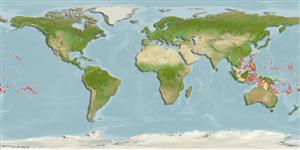>
Eupercaria/misc (Various families in series Eupercaria) >
Labridae (Wrasses) > Cheilininae
Etymology: Cirrhilabrus: Latin, cirrus = curl fringe + Greek, labros = furious (Ref. 45335).
More on authors: Randall & Pyle.
Environment: milieu / climate zone / depth range / distribution range
Ecología
marino asociado a arrecife; rango de profundidad 3 - 40 m (Ref. 9710). Tropical
Distribución
Países | Áreas FAO | Ecosistemas | Ocurrencias, apariciones | Point map | Introducciones | Faunafri
Pacific Ocean: Great Barrier Reef to the Pitcairn Group.
Tamaño / Peso / Age
Maturity: Lm ? range ? - ? cm
Max length : 13.0 cm TL macho / no sexado; (Ref. 2334)
Short description
Claves de identificación | Morfología | Morfometría
Espinas dorsales (total) : 11; Radios blandos dorsales (total) : 9; Espinas anales: 3; Radios blandos anales: 9. Body is green posteriorly , shading to dusky blue-green in the middle, and to brighter blue-green anteriorly and on postorbital portion of the head; lower fourth of the body light red; postorbital head and anterior upper half of the body finely speckled with black; snout greenish yellow.
More common in outer reef areas than sheltered lagoon reefs. Usually seen in small groups feeding a short distance above the bottom on zooplankton. These groups are composed mainly of females and juveniles. Males in courtship, actively swim up to 3 m or more above the bottom with fins fully erect.
Life cycle and mating behavior
Maturities | Reproducción | Spawnings | Egg(s) | Fecundities | Larva
Distinct pairing during breeding (Ref. 205).
Randall, J.E., G.R. Allen and R.C. Steene, 1990. Fishes of the Great Barrier Reef and Coral Sea. University of Hawaii Press, Honolulu, Hawaii. 506 p. (Ref. 2334)
IUCN Red List Status (Ref. 130435)
Threat to humans
Harmless
Human uses
Pesquerías: comercial; Acuario: Comercial
Herramientas
Special reports
Download XML
Fuentes de Internet
Estimates based on models
Preferred temperature (Ref.
123201): 24.7 - 28.9, mean 27.4 °C (based on 160 cells).
Phylogenetic diversity index (Ref.
82804): PD
50 = 0.5000 [Uniqueness, from 0.5 = low to 2.0 = high].
Bayesian length-weight: a=0.01585 (0.00707 - 0.03555), b=2.95 (2.76 - 3.14), in cm total length, based on LWR estimates for this (Sub)family-body shape (Ref.
93245).
Nivel trófico (Ref.
69278): 3.4 ±0.45 se; based on food items.
Resiliencia (Ref.
120179): Alto, población duplicada en un tiempo mínimo inferior a 15 meses (Preliminary K or Fecundity.).
Fishing Vulnerability (Ref.
59153): Low vulnerability (10 of 100).
Nutrients (Ref.
124155): Calcium = 98.6 [57.7, 182.2] mg/100g; Iron = 0.881 [0.506, 1.670] mg/100g; Protein = 18.2 [15.3, 20.4] %; Omega3 = 0.161 [0.095, 0.269] g/100g; Selenium = 23.7 [13.6, 46.1] μg/100g; VitaminA = 226 [69, 811] μg/100g; Zinc = 1.7 [1.1, 2.7] mg/100g (wet weight);
